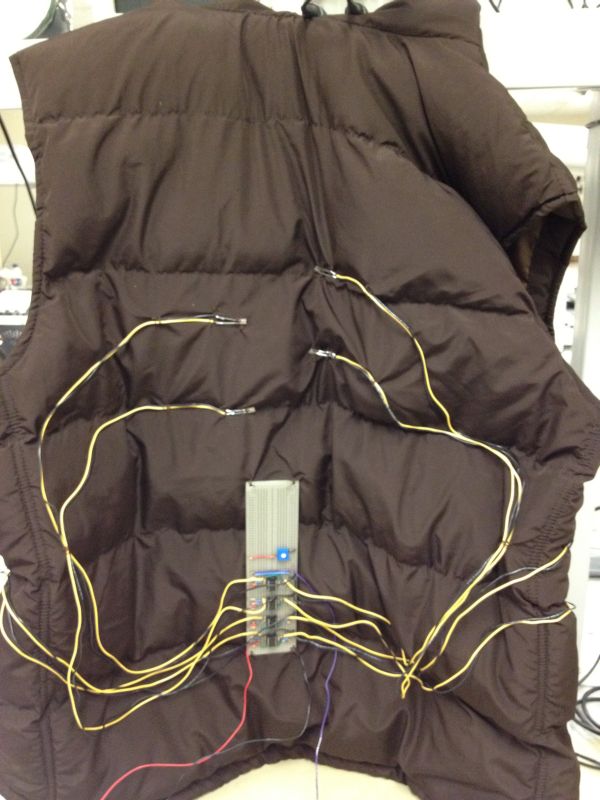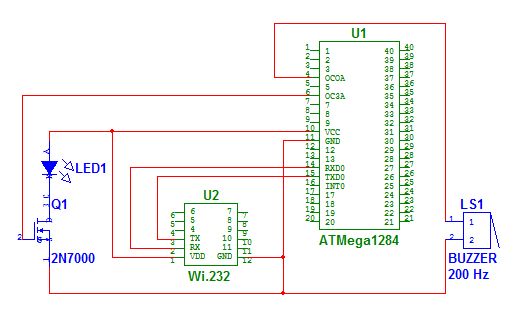Introduction
This project implements an Identification Friend-or-Foe (IFF) system for use by soldiers to prevent friendly-fire. The inspiration for the project is derived from Identification Friend-or-Foe (IFF) transponder systems currently used on fighter aircraft and military vehicles. Fighter aircraft fitted with an IFF system transmit a coded radio (RF) message to other aircraft detected within a pre-set range. Friendly aircraft can decrypt the RF message and provide a correctly encrypted response to prevent fratricide.

Each soldier’s rifle is fitted with a laser that sends out an IFF query. If a friendly soldier is in the line of sight of such rifles, the IFF system produces a feedback signal. This signal can be used to generate an audible/visual warning, or to momentarily jam the rifle.
High Level Design
Rationale
System Architecture
The grayed boxes in Figure 1 are parts of the system implemented in software on a microcontroller unit (MCU). The white boxes are implemented in hardware. A soldier equipped with the IFF system has a responder unit on their body armor, and an initiator unit mounted on their rifle. The rifle module uses a laser to transmit an encoded message – the IFF query. If the rifle points toward a friendly soldier, phototransistors mounted on the target soldier’s body armor will detect an incident laser beam. An MCU in the responder unit will decrypt the laser message using a pre-set private key. If decryption is successful, the MCU identifies which friendly soldier is currently aiming at the target soldier, and broadcasts this information in RF. RF receivers in the initiator units of all friendly soldiers within firing range parse this information to determine if the rifle they are mounted on is pointing toward a friendly soldier. If potential fratricide is detected, a buzzer mounted on the rifle goes off, signaling that the current rifle position might result in friendly fire. This feedback signal used to trigger the buzzer may also be used to prevent the next round from being loaded in the weapon’s firing chamber.
The IFF system has two major fault cases:
- Hostile forces may try to masquerade as friendly forces by detecting the laser IFF query and responding with an RF broadcast. A pre-set private key encryption system is used to prevent hostile forces from decrypting the IFF key. A similar encryption system can be used to safeguard RF communications. This problem must be handled by generation of secure keys, and at the operations level by regular key changes like IFF systems currently in operation in fighter aircraft. Our prototype uses a trivial encryption scheme for the laser IFF query and no encryption for the RF messages in order because it is designed to be a proof of concept only.
- Hostile forces may recover the responder modules of the IFF system from dead soldiers and use it to masquerade as friendly soldiers. A plethysmograph monitors the soldier’s pulse. If the heart rate falls to zero, the MCU in the responder unit can wipe its program memory to deny use of the unit to hostile forces. A similar scheme can be implemented to prevent hostile forces from using the initiator unit on rifles. Our prototype implements the plethysmograph system on the responder unit only, and turns on a red LED instead of wiping program memory.
Hardware/Software Trade-offs
Laser vs Directed RF
We explored a ‘cantenna’ and custom axial mode helical antennas to produce a sufficiently directed RF signal. Helical antennas were too expensive to be viable for mass deployment, and the cantenna failed to attenuate the RF signal sufficiently in directions other than the line of fire. We decided that the inherent coherence and collimation of a laser compared to a directed RF signal outweighed the disadvantage in encryption schemes.
Diverging vs parallel Laser Beam
Real Time Operating System vs Manual Scheduling
Consolidating Received Signal
Standards
UART
FSK/CSMA: FCC Regulations for RF
ANSI Z136
IFF Federal Standard
IFF is defined by the Federal Standard 1037C as:
Identification, friend or foe (IFF): A system using electromagnetic transmissions to which equipment carried by friendly forces automatically responds, for example, by emitting pulses, thereby distinguishing themselves from enemy forces. [JP1] Note: The secondary surveillance radar (SSR) system used in modern air traffic control systems is an outgrowth of the military IFF system used during World War II. The IFF equipment carried by modern military aircraft is compatible with the transponder system used for civilian air traffic control.
Software
Friendly Fire Detection | User Validation | Collision Avoidance | Real-Time Operating System
Friendly Fire Detection
User Validation – Plethysmograph
The program memory can either be wiped with the chip erase command by setting the command byte to 1000 0000, or by overwriting program memory.

Collision Avoidance
Real-Time Operating System
System Overview
We use the TinyRealTime (TRT) kernel system to schedule our various software processes and ensure that deadlines are kept. This helps us abstract away the complexities in managing multiple tasks that need to execute while UART communication is ongoing. The TRT system also provides semaphores to ensure mutual exclusion when accessing shared resources such as the UART channel across different processes.
Task Configuration
Initiator Module
The inititator module only has one task, laser_recv, which sets up the laser signal and checks periodically for a friendly-fire signal from the responder unit.
Responder Module
The responder unit has the following three tasks:
- setup_send: Checks the frequency of interrupts from the input sensors, and sends a “friendly-fire” signal to the initiator unit. Once the frequency falls outside the valid range, it sends another “cease” siganl to the initiator unit to indicate that it can resume normal operation
- plethys: Sets up the analog interrupts for the plethysmograph, and checks if there is a pulse rate within the last 4 seconds. If not, light up an LED to indicate system will be unresponsive (in the field, the system will erase its memory)
- check_plethys: A task to debounce the analog interrupts from the plethysmograph
Hardware
Overview
Initiator Unit
The initiator unit generates a laser signal along the weapon’s line of firing. The microcontroller generates a PWM signal that operates a MOSFET switch, which in turn regulates the laser output. This creates a laser beam that appears to be steady to the observer, but is actually a very rapid series of pulses with an interval unique to each soldier.
Parts List:
| Item | Part Number | Vendor | Price | Quantity | Total Price |
| ATMega1284 | Lab Stock | $5.00 | 2 | $10.00 | |
| PCB for ATMega1284 | Lab Stock | $4.00 | 2 | $8.00 | |
| White Board | Lab Stock | $6.00 | 1 | $6.00 | |
| Solder Board (6 inch) | Lab Stock | $2.50 | 3 | $7.50 | |
| 40-pin DIP Socket | Lab Stock | $0.50 | 2 | $1.00 | |
| 8-pin DIP Socket | Lab Stock | $0.50 | 4 | $2.00 | |
| SIP Sockets | Lab Stock | $0.05 | 24 | $1.20 | |
| Header Socket | Lab Stock | $0.05 | 72 | $3.60 | |
| LEDs | Lab Stock | $0.00 | 2 | $0.00 | |
| Resistors | Lab Stock | $0.00 | $0.00 | ||
| Capacitors | Lab Stock | $0.00 | $0.00 | ||
| Wires | Lab Stock | $0.00 | $0.00 | ||
| Wi.232DTS-EVM-R Radio Module | Lab Stock (donated by Dr. Bruce Land) | $0.00 | 2 | $0.00 | |
| Dual-Convex Lens | L5315 | Surplus Shed | $4.00 | 1 | $4.00 |
| 650NM Laser Module (Class IIIA) | VLM-650-03-LPA-ND | Digi-Key | $13.18 | 1 | $13.18 |
| 940NM IR Emitter (Clear, Side Look) | 160-1063-ND | Digi-Key | $0.49 | 1 | $0.49 |
| NPN IR Phototransistor (Clear, Side Look) | 160-1065-ND | Digi-Key | $0.46 | 9 | $4.14 |
| 9V Battery Holder | BH9VW-ND | Digi-Key | $1.51 | 2 | $3.02 |
| DC/DC Converter (+/-5V Out, 2W) | 102-1521-ND | Digi-Key | $13.66 | 1 | $13.66 |
| Piezo Buzzer (4kHz, 12.2mm) | 445-5229-1-ND | Digi-Key | $0.79 | 1 | $0.79 |
| Battery Alkaline 9 Volt | P647-ND | Digi-Key | $1.98 | 2 | $3.96 |
| Op-Amp IC, 700KHZ | LM358P | Digi-Key | $0.49 | 4 | $1.96 |
| Op-Amp IC, JFET 3MHZ | LF353P | Digi-Key | $0.63 | 2 | $1.26 |
| Cable Assembly, Barrel Power | CA-2185 | Digi-Key | $1.90 | 2 | $3.80 |
| Brown Vest (Old) | Aadeetya | $0.00 | 1 | $0.00 | |
| Grand Total: | $89.56 | ||||
For more detail: IFF System for Infantry Using Atmega644
